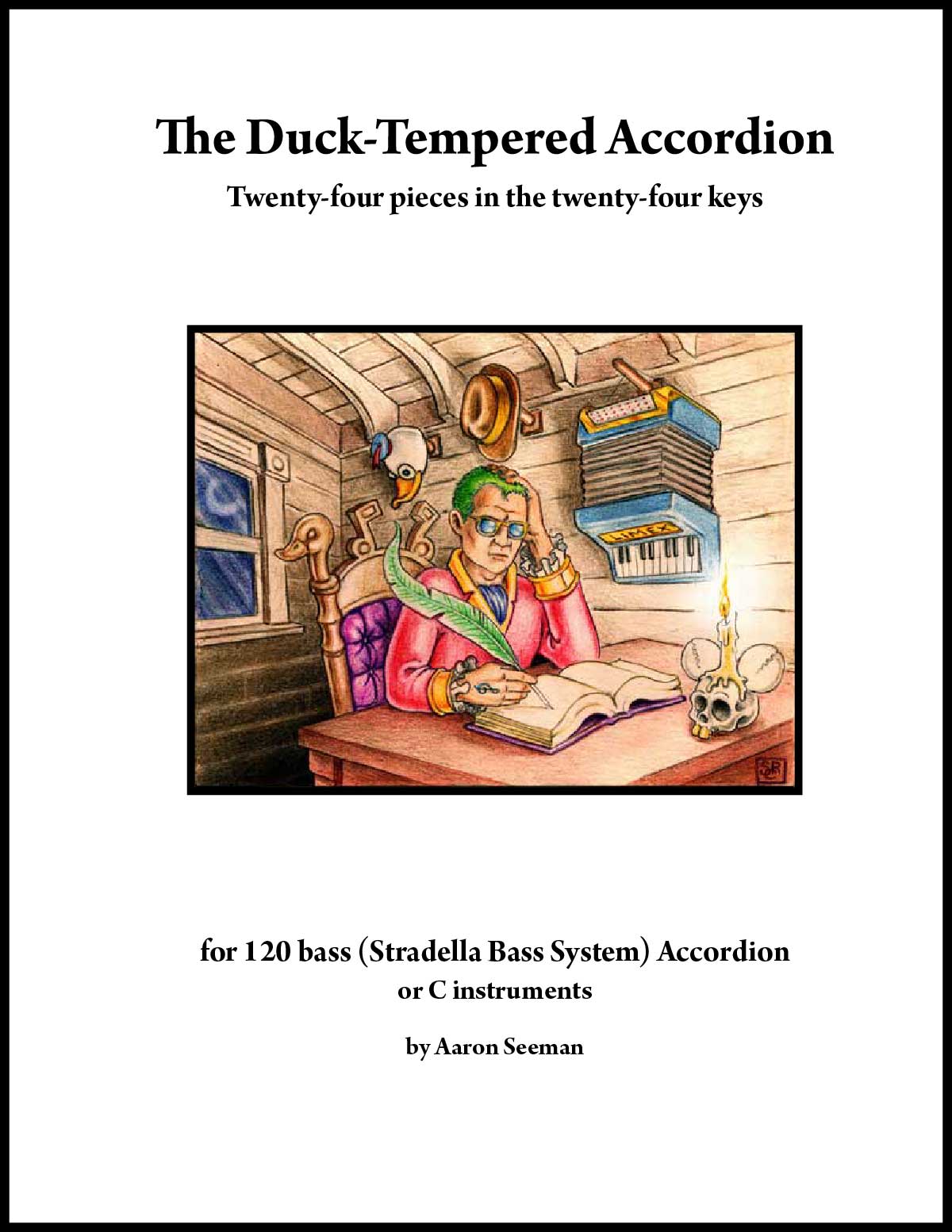The Duck-Tempered Accordion
Twenty-four pieces in the twenty‑four keys
for 120 bass (Stradella Bass System) Accordion
or C instruments
by Aaron Seeman
I began composing accordion pieces in 2001 or 2002. I soon had the idea of writing one piece in each of the 24 keys, partly as a way to improve my own technique on the instrument. After an initial burst of work in 2001-2002, other projects kept me distracted. I did only intermittent work until late 2009 - early 2010, when I cleaned up and finished existing pieces, discarded and rewrote several, and filled in some missing keys.
Between 2006 and 2009 I recorded several of these pieces as Duckmandu, with Shamalamacord, and with Fishtank Ensemble. Several appear on Duckmandu’s “Shut the Duck Up and Play Your Accordion,” “Tanuki Says Meow” appears on Shamalamacord’s self-titled CD, and Fishtank Ensemble recorded “Itty-Bitty Snitty Little Frenchman.”
Among the stylistic influences are Klezmer (Eastern European Jewish folk music), Balkan folk music, Swedish Folk Music, and Classical music. There are polkas, waltzes, études, and many that are hard to classify. In difficulty they range from early intermediate to advanced.
Though the title of this collection and the order of keys (chromatic rather than circle of fifths) suggests Bach’s Well-Tempered Clavier, it is really more in the spirit of Chopin’s Preludes.
This music was composed for 120 button Stradella Bass System keyboard accordion with a standard piano keyboard range (F below middle C to A two octaves and a sixth above middle C). Most of the pieces were written while playing a Giulietti accordion with four registers and no tone chamber. The pieces should work well for chromatic button accordion with Stradella, or even for free-bass accordions if the player can do some translation from the Stradella notation.
Most of the pieces have chords above the staff, so the treble or keyboard part can be used as a lead sheet for different instruments or ensembles. The bass or buttonboard part can be referred to for intended rhythms.
Normally accordion notation uses a short dash to indicate that a bass note should be played on the counterbass column. This can be ambiguous, as the same symbol is used to indicate tenuto, or holding a note for its full value. To avoid this confusion, I put all counterbass dashes beneath the note, and tenuto is indicated with a dash above the note.
Register is indicated for the keyboard side only. The buttonboard settings left to the player’s discretion, but should usually be set to Master. The registration symbols (the circles with lines and dots!) were made in Adobe Illustrator and are available for download at no charge from www.duckmandu.com.
“Liam Meets the Little People” notates the keyboard part in G# but respells the buttonboard part in A-flat. This is not polytonality, it’s simply that it’s much easier to play the buttonboard part on the flat keys, and it is much easier to read the keyboard part in G# minor.
“B Minor Prelude and Fugue United” is based, as the title suggests, on themes and harmonies from both the B minor Prelude and the B minor Fugue from J.S. Bach’s “Well-Tempered Clavier #1.” I was trying to conjure forth a worthy finale for this volume, and I realized that Bach’s monumental finales to WTC #1 were always in the back of my mind. I noticed that if you took the bass from the prelude and played it at the same time as the subject from the fugue (augmenting the eighth notes to quarter notes), the melodies harmonized for two measures. With that discovery as a starting point, I wrote the piece. It is not a fugue; there are not really any fugal answers or countersubjects, rather it reintroduces the subject in different keys, registers, tempi and tonalities as well as themes from the prelude. I wanted to evoke Bach’s finale while still creating (I hope) an original composition. Bach’s B Minor Fugue is famous for containing all 12 notes in the subject and presents unique challenges to the composer and performer. I have not indicated which bass notes should be played on counterbass, as there are many possible solutions. In keeping with the source, there are no dynamics, but the indicated tempo should approximate the Largo Bach indicated for the Fugue. The slurs on the fugue subject are also from the original.
